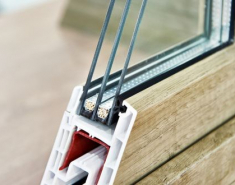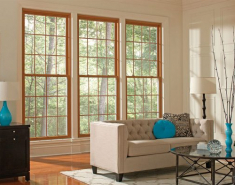Replacing an exterior door: Experts’ tips to do it right
How great would it be if you could just pop out your old front door Lego-style and replace it with a new one? In one bold move, you could change the look of your house from Moorish to modern farmhouse and at the same time make your home safer and more secure.
Unfortunately, it’s not that easy; replacing an exterior door requires exact measuring, medium-to-advanced carpentry skills, and an understanding of terms and materials. Hunter MacFarlane, a Lowe’s project expert, says, “If you’re unsure about managing and finishing the project within a day, I’d recommend calling a professional.”
Whether you are gutsy enough to take on a DIY door replacement or decide to call in a professional to do it for you, here are some things you should know:
What kind of door
First you need to understand the difference between a slab door, which is just the door, and a pre-hung door, which includes both the door and the frame that supports it.
Natedra Banks, senior merchant of exterior doors at Home Depot, says it is possible to replace just the door slab, but hinge positions and lock bore positions vary from one manufacturer to another, so a new door is not likely to align properly. Actual door slab sizes also vary depending on the age and manufacturer of the original door.
“Replacing just the door might not improve your entranceway as much as replacing the entire unit. Your existing door frame could have wood rot or may not seal as well as a modern door system,” Banks says. And if your slab door is more than 25 years old, you should use a pre-hung door to ensure a sealed frame. Banks sums it up: “Replacing the door only is like buying a new car and keeping your original tires.”
Measurements
If you can get away with replacing the door slab only, correct dimensions are imperative. “If the measurements are taken correctly, then replacing the door is as simple as removing the hinge pin, reinstalling the jamb leaves on the door, installing the lock and deadbolt hardware, reengaging the hinges, and assembling each hinge by reinserting the hinge pins,” Banks says. (This still sounds overwhelming to me.) The measurements you need are door height, door width, hinge locations, hinge type (pass-through or mortise), hinge size, lock and deadbolt locations from the top of the door, and the backset of the lock and hinge locations.
If you are replacing the entire door system, depending on type (single, double, doors with sidelights, doors with transoms, etc.), the measuring and installation is considerably more difficult. Although you would not need to worry as much about the door height and width, you do need to determine the unit size and/or the rough opening to ensure the new system fits into the opening. “If it is new construction, this is generally easier, as you would not already have a unit in the opening,” Banks says, “but if it is a repair/remodel, you will need to remove the existing pre-hung unit.”
Material
To determine what type of material your door should be made of, consider your budget and the level of maintenance you are willing to do. Banks says steel doors are a great entry-level option because “they’re durable, budget-friendly and offer a wide range of design choices, including colors and glass options.” MacFarlane adds that steel doors are also a good choice because they resist shrinking, swelling and warping, require little maintenance, and are energy-efficient.
Banks also recommends fiberglass, a material that requires almost no maintenance because it does not dent, rot or rust. And, MacFarlane adds, “fiberglass doors are energy-efficient, affordable and made to last in all climates — plus you can paint them any color or stain them to get a woodlike effect.”
Wood doors, while beautiful, are more expensive and require maintenance, especially with high exposure to the elements. But, Hunter says, “they are strong and secure, and scratches repair with ease.”
The cost of a new door — pre-hung or slab — will vary based on the material type and whether the door is stock or special order, Banks says. Doors range from the mid-hundreds to more than $3,000 for highly configured items.
Hardware
MacFarlane says it is not necessary to have your door hardware picked out before you order a new door, as long as the door is ordered with a standard cylindrical lock bore for a 2⅜ -inch or 2¾ -inch backset. Some door manufacturers offer a handle set that can be included with the door, which simplifies the project. MacFarlane says it’s smart to decide early whether you want extra security, such as a chain lock or a stopper if your door swings inward.
Update instead of replace
If you are thinking of replacing your door because of draft, you should first check your weatherstripping and/or door sweep; both can wear over time and are much easier to replace than an entire door. However, Banks says, “if the door or frame are bowed or warped or if the door was poorly installed from the beginning, you may need a reinstallation of the unit or total replacement.”
If an updated look is all you are after, designer Robert Lindgren from Lindgren Gibb Studio suggests giving a plain solid door a makeover by covering it with three square panels of simple stock molding. Taking inspiration from Dorothy Draper and David Adler door designs, Lindgren suggests finishing the door in a high-gloss paint. Another quick update for anyone who wants a Spanish colonial or Tudor-style door (Lindgren says to “think ‘Game of Thrones’ ”) is to use hammered nailheads. Simply tape out a pattern or design on the door and then bang in the nails.
Source: https://wapo.st/2U82DC0









